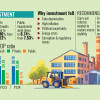How grave is the investment situation?
While many econo-mists are panicked about the current level of investment growth, the situation warrants further investigations. Many economic indicators are obviously down, but they do not pose a threat of recession for the nation. Nor do they signal any crisis creeping insidiously on the sustained mood of business. Bangladesh's current investment situation is not depressive once the global effects and internal incidences are taken into account.
The bubbles in the stock market went bust some four to five years ago. Subsequently, the real estate sector embraced the decline that still persists in the market. These two big events have been enough to impede the growth in private sector credit, which is now slightly above 13 percent. This number may appear much lower than that of 2011 and 2012, when private credit growth exceeded 20 percent. But that period of private credit ballooning should be viewed as an exception rather than normalcy.
Several credit scams crowded those years, necessitating harsh supervision and stricter rules from Bangladesh Bank. A sudden spike in central bank vigilance alerted the financial industry. And the whole banking sector began to behave in an overcautious fashion while approving loans since then. Its impact on investments has surfaced of late as expected. An episode of adjustment and correction of past mistakes has overwhelmed the lending practice. Hence, a tune of credit conservatism prevails in the air of the banking arena. While the negative side of this conservatism is slow growth in private loans, the positive side marks a new phase of enhanced credit quality.
Credit growth over 20 percent some 3 years ago, looked hugely optimistic but it eventually contributed to output growth of just over 6 percent – a similar rate which is now coming from a much lower credit growth at 13 percent. Where does the puzzle lie? The current credit growth of 13 percent proves an emphatic improvement in the quality of credit, which the banking industry must practice to ensure sustainable output growth. In addition, most banks have been capable of preventing potential looters of bank money from entering the premises. Fraudulent lumpy loans have dwindled in both number and quantity, enabling the existing credit to register higher marginal productivity than before.
This qualitative improvement of private credit has escaped the eyes of many critics who foresee dismal output growth based on a 13 percent credit growth. Given that India scooped up as high as 8 percent output growth by nurturing only 15 percent private credit growth, achieving over 6 percent output growth, 13 percent private credit growth should not be a daunting task at all.
Private credit has kicked off a new era of compositional change. More loans are being disbursed for agriculture, small and medium enterprises (SME), green projects, and women entrepreneurship schemes. This transformative change in credit composition, which we never saw before, might have slowed down the expected growth in private credit because of exploring new paths of credit worthiness. The share of SME loans in the total outstanding credit was 18 percent in 2007, and now it has reached 24 percent. The time will come when SMEs will take up 50 percent of total loans and contribute to massive employment generation particularly in the rural economy, stemming the concentration of workers toward the two megacities, Dhaka and Chittagong.
The Bangladesh economy would badly need this credit diversification through financial inclusion to cement balanced growth in the years ahead. A society cannot bridle the ever growing disease of income inequality if enormous credit inequality is not nipped in the bud. And that is why a new era of developmental central banking in Bangladesh is committed to empowering the poor, patronising women leaders, and stimulating rural economies that feed the nation.
When the whole of Europe, which is the biggest importer of Bangladeshi goods, is floundering in recession, Bangladesh cannot expect a buoyant export market. Since 80 percent of our exports are garments – that necessitate import of raw materials through back-to-back letters of credit – import growth is expected to remain lukewarm. Drastic collapse in oil prices suppressed the revenue income of the Middle East, weakening our remittance inflow. Thus, all three star performers of our current account, exports, imports, and remittances, display some degree of debility that is attributable to external reasons, not to internal failures or political uncertainty.
Some businessmen, being obsessed about investing overseas, are demanding capital account convertibility at a faster pace. There is no room to see this development as a sign of domestic weakness. Rather, these companies have a strong domestic presence and now they think of cross-border expansion in this age of globalisation. However, the rate of return in Bangladesh is still high enough to attract new businesses. The businesses that desperately seek to install plants in foreign lands did not exhaust domestic possibilities by scanning our potential.
Since we embarked on liberalisation in the early 1990s, every regime of the country has been favouring the business community in a competitive fashion, and hence political uncertainty is not a valid excuse for not investing in a vibrant Bangladesh. Let us reassess our motherland of possibilities before someone else from the overseas does it. Then the investment scenario in Bangladesh will not look as bleak as seen by some critics nowadays.
The writer is Chief Economist of Bangladesh Bank.

 For all latest news, follow The Daily Star's Google News channel.
For all latest news, follow The Daily Star's Google News channel. 








Comments